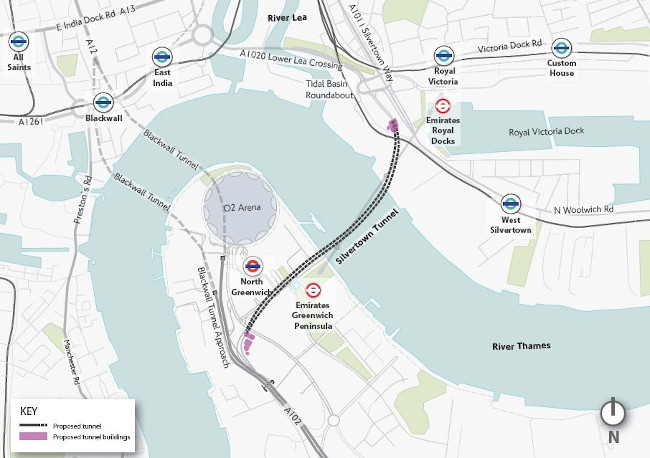
The 25-year design, build, finance, operate and maintain contract includes the design of a 1.4km twin-bore tunnel under the River Thames as well as 0.6km of access ramps.
When it opens in 2025, the new tunnel will be the first major road crossing across the River Thames since the opening in 1991 of the Queen Elizabeth II Bridge downriver from London and near the town of Dartford. When the new tunnel is opened, users of it and the Blackwall Tunnel will pay an as yet undecided toll amount.
The consortium’s construction team of

Over the past 30 years, the East London region – that takes in areas north and south of the River Thames - has seen significant population growth. However, there has been little major investment in the area’s road infrastructure. The local population is expected to increase further in the next decades, putting yet more pressure on the ageing Blackwall Tunnel.
Transport for London (TfL) said that its modelling shows that without Silvertown Tunnel, both traffic and emissions from vehicles queuing to pass through the Blackwall Tunnel will worsen over the coming years. Delays in the morning peak time across east and southeast London are expected to increase on average by more than 20% between now and 2021.
RiverLinx and TfL have said the Silvertown project will significantly reduce this congestion – as well as improve the air quality in and around the nearby 122-year-old Blackwall Tunnel. It should result in a six-fold increase in public transport provision across the tunnels’ area of the River Thames.
The Silvertown Tunnel will also be the UK’s first major road tunnel to include a dedicated bus lane in both directions. TfL expects around 37 buses an hour during peak periods in each direction will use the tunnel, including the six single-decker buses per hour that now run through the Blackwall Tunnel.
This will result in the proportion of cross-river trips via public transport in this area rising from 10% to 30%. These buses are all expected be zero emission vehicles and will support the growing demand for bus transport across the London boroughs of Greenwich, Newham and Tower Hamlets.
The tunnel is to be located within London’s extended Ultra Low Emission Zone. From October 2021, any vehicles not meeting strict emission standards will have to pay an additional charge – above the regular toll - to TfL to use the new tunnel. The contract also requires RiverLinx to improve the urban environment either side of the river, enhancing public spaces and promoting more walking and cycling.
The project will run for 25 years beyond construction, with RiverLinx responsible for the operation and maintenance of the project. TfL will start paying for the project only once the tunnel is operational, limiting their financial exposure on the project.
TfL has said that 15 international lenders are provide financing for Silvertown, including
There are also strict environmental criteria for contractors working on the tunnel and the external ramps, according to TfL. Most of the construction material will be transported by river and all on-site construction machinery will meet the mayor's Non-Road Mobile Machinery Low Emission Zone Standards. Any vehicle working on the scheme will be Euro VI engine compliant.
Financial closure was delayed by around five months because of a legal challenge over the awarding of the contract to RiverLinx. In August the losing bidder Silver Thames Connect (STC) filed the challenge with the Technology and Construction Court. STC consortium partners include
The court was set up in 1998 to hear disputes arising in the field of technology, engineering and construction. It also hears professional negligence claims and IT disputes as well as allegations of lawyers’ negligence arising in connection with planning, property, construction and other technical disputes. It normally handles cases only with a value of more than £250,000.
In the case of the Silvertown Tunnel dispute, the court lifted the suspension of the awarding of the contract but is allowing STC to pursue its claims over issues concerning procurement processes.








